How not to create a product for people who do not exist
The article contains a free translation-synopsis of Arthur Bodolec , product designer on Facebook, in the past design co-founder at Feedly.
The article will be useful to those associated with the design of interfaces. The material seems important to us, because many say “communicate with your users,” “listen to your users.” Arthur Bodolec tells how he does it, shares practical steps from his experience.
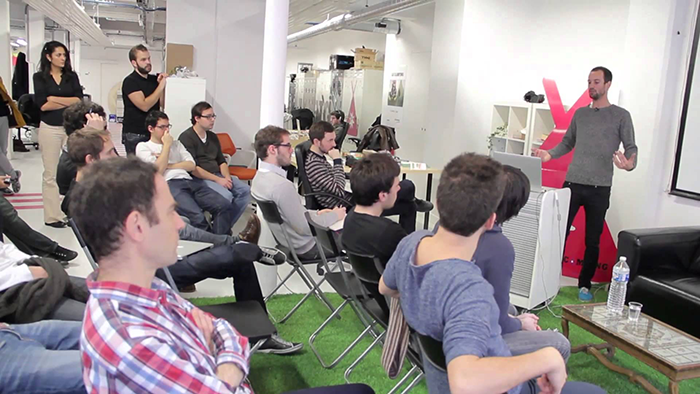
This article is a free translate-outline, therefore inaccuracies are possible. We will be grateful if you help make the article better.
First person narration, italics are our comments.
')
Today we will talk how to do design listening. Hearing is a key skill in design.
You all start your projects in the dark. As soon as you find an idea, you see the light. It becomes clear to you what the product should be, you come closer to how it should look. You start coding with friends like crazy. You hope that a year after launch you will enter the IPO. In reality, this does not happen.
Users enter the site and do not understand what it is about; they cannot find the necessary functions. Maybe they don't know what to look for. You begin to study user behavior, to iterate. It is sad that you have already spent 6 months on the launch of the product and only now begin to understand how to use it.
I propose to study user behavior before launch. And tell you how I do it.
The first problem you encounter is finding people to talk to. You can start with friends. But this is not the best choice, often they are not your audience.
If you make a product for homeowners and talk to friends who have never lived in their own homes, there will be many opinions, but they will not be super useful for you. Although it is still better than not talking to anyone, try to filter friends, whether it is your audience or not.
Facebook, mail, Twitter
Use Facebook or Twitter account. Ask subscribers to help, they can be your audience.
If you have already published a draft and you have letters from users, write to them. Ask for 15 minutes of their attention to find out how and why they use your product.

Bulletin Board
If you cannot use these tools, refer to Craigslist ( craigslist.org - the famous ad site ) where you can post a small task. This is a great place where they do not know about your product, but there is your target audience. I will briefly tell you how to work with services like Craigslist. This is what the ad looks like:
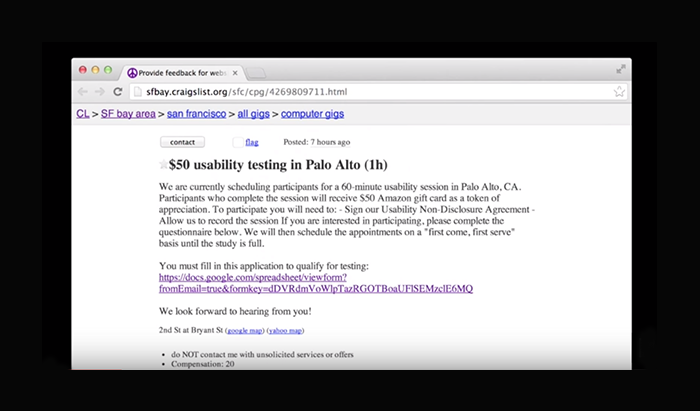
In the video, Arthur talks about the site craigslist.com, in our realities, task execution services where people are looking for a side job may be useful.
Put a price in the heading and write what the task is. People looking for a part-time job will understand that this is testing some kind of product, it costs $ 50 and it is in Palo Alto.
- In the ad do not say anything about your product.
- Tell me how long it will take and that you will need to sign an NDA so that there are no surprises.
- Warn that the video will be recorded.
For applications I use Google Form. If a person wants to send an application, he enters the form and answers 5-10 questions. It helps to understand who he is. For example, you make a product for people who like to read. By asking the right questions in the form, you will find out if the respondents really like to read. This will help to get an idea of your potential target audience.
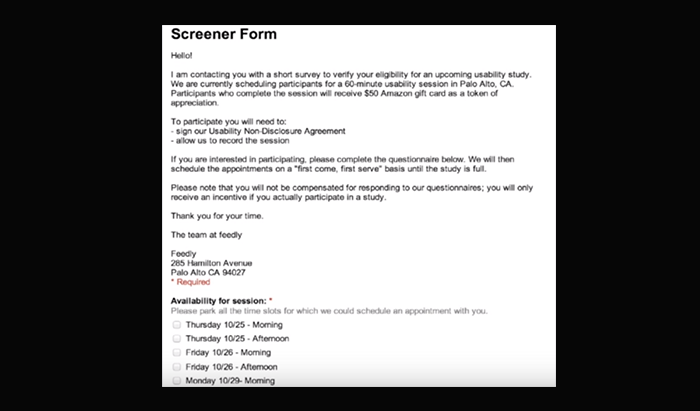
You make a list with the criteria of people you want to hear. These questions will help you form the criteria and submit the questions to the Google Form.
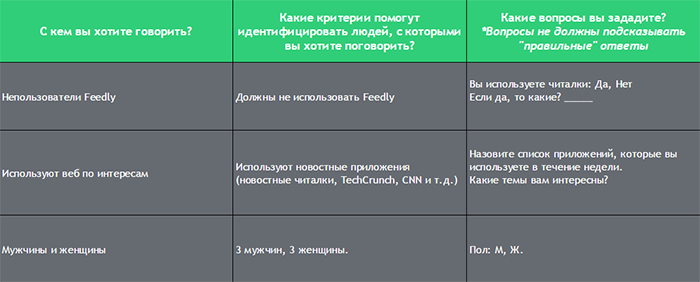
For me it is important that users do not use Feedly. I want to see how they use the service for the first time. For example, if the user answers the question: “Which readers do you use?”, He answers: “Feedly”, I will not include him in the interview sheet.
Then you make a list of criteria for those with whom you do not want to talk.

I do not want to talk with designers, programmers and project managers, because they are experts. Their opinions will not be helpful in terms of regular user scripts.
All these requirements you formulate and enter into the Google Form, and then publish. When applications come, you highlight those green that you may be interested in. And after that you can ask the authors of these applications questions, test the product, etc. You can use all these tools - Facebook, Twitter, mail, etc., to find the right people, those with whom you can talk. You select those criteria that are relevant to your product.
You have selected people, now make sure you understand them. Even before I make a new feature or begin to design something, I collect stories.
You need to collect real stories from real people. Often the problem is that within a company or a startup you are supposed to represent one or several characters. You start to think about who they are: he has two children, a car, a house, he uses this or this product ...
And then you start creating designs for people who don't exist. You imagine that they exist, but it is not. You can guess a few things, but the bulk will be unreal. What you need are real stories from real people. And each time, discussing a function within a team, you can always return to Georges, with whom you spoke, and ask him questions.
This thesis seems to us the main idea of Arthur's speech. Many materials say that we have to imagine the characters, their needs and scenarios of interaction with the product. In practice, it may turn out that we initially come up with a character that is convenient for us, comfortable cases and the needs we need. Which are cut off from reality. And based on this build a product. A product for people who do not exist.
Arthur proposes to take real people as a basis.
Now I will show you the key questions that I ask users to get interesting stories.
First of all, you need to understand who they are.

I ask: “ Did you use any services before Feedly? ". In your case, you can ask how they solved their problem prior to your product.
Next key question: “ Why do you use our product? Or why would you use our product? "
This is the most important question of all and is the hardest to ask. Because, as a rule, people answer not what would be useful. I'll show you an example. I usually write to users on Skype:
- Why are you using feedly?
I always answer: " To read all my subscriptions in one place ."
But it does not really help me in the design. Therefore, using the answer of the user, I ask again:
- Why do you need to read all these subscriptions?
Answer:
- ABOUT! To have access to this information.
Again not very helpful. Therefore, you repeat the method:
“Why is it important for you to have access to this information?”
And then users start saying interesting things:
- To be inspired by a new book .
- Improve my professional skills .
- Know about the latest changes in legislation .
Now I understand who these people are, why they use Feedly, and I can ask my questions further. It helps to create design and features for real needs.

Hearing about any service, ask how the user uses it. For example, Twitter. Both in Feedly and Twitter you can receive information:
- You say you use Twitter, what's the difference between Twitter and Feedly? Why do you use both services?
And users begin to explain to you how they think:
- Feedly is where I get information, Twitter is where I discuss it.
It is very important to know how they see your product, how they see other products. It is important to make this map, it is their perception, not yours. Listen carefully to these things.
If you have enough time, ask more questions:
- What upsets you?
- What one thing makes you happy when you use Feedly?
- If you could leave one function, what would it be?
It is very interesting that if you ask which function to leave one, they call the most insignificant feature. Often the answer will surprise you very much. It is important to get out of your product image and listen to the user. Often you will hear what you do not expect.
Starting a new feature, ask the users about it.
Starting a new feature, before you start drawing anything, take people and check this script for them. Only 3 questions:
- Who are they?
- Why do they use the product?
- Why do they need this feature?
As a result, you get real stories. Which show how people use this or that feature. It is good to have 10-20 such stories. You can hang these phrases on the wall to keep them before your eyes when you create a design. You get a lot of stories, very specific and real, and then you can categorize them.

Test not necessarily an existing product on millions of users. You can test and draw the layout. You need to get at least some feedback. Do you shoot in the right direction?
There are 2 main methods here.
First: the discovery method
The idea is that you want to test the first experience of interacting with the product or features. You want to know here: do they understand your product or feature?
You put the user in front of the product and see how he understands it. Does he really go through the scenarios that you asked. Can he find the key features that you created.
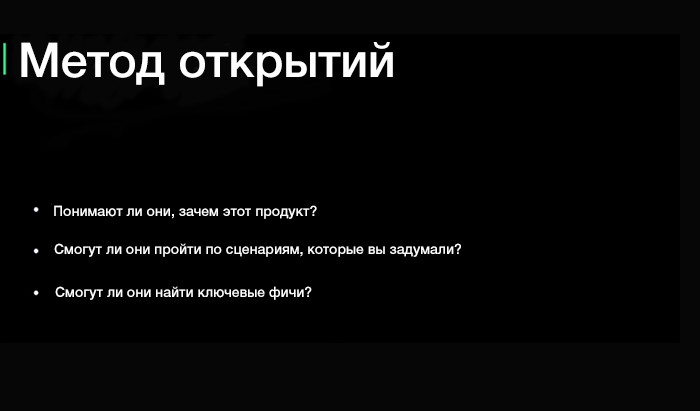
Key point: you do not interfere in this process. Just give them the opportunity to "get lost", let them go. When will they start asking, “Why is it like this here? Why is that? ”- don't say anything, just give them the opportunity to“ get lost ”. Answer the questions: "I do not know."
Second: feature method
The key point is to ask people to do certain things in your product. Find a feature, buy a product, change a profile, etc. Can they do it?
Can you find _______?
How to start _______?
Before the interview, you simply make a list of what the user should find.
I combine these two methods. I plant them before the product and do not say anything, and then I give tasks and ask specific things. During the interview, it is important to bring a few things:
- You can not do anything wrong.
- Do not be afraid to criticize and offend our feelings, we want to learn.
- Think out loud and tell us what you want to do and what you feel.
- The screen and sound will be recorded.
- No one will say "this is obvious!" Do not be afraid.
It is very important to ask them to think out loud. You care what they think.
Your actions:
- Do not tell about your product, do not customize users.
- Let people use the product and “get lost”.
“If they did something wrong, ask them why they did it.” Do not try to guess. We often guess.
- From general questions go to narrowly focused.
- If something is not clear, explain.
"Ha-ha" moment
You will have a lot of information, but you pay attention to 2 things:
- “Ha-ha” moments.
- Confusing and misleading interface elements.
What is the “aha” moment? One of those moments was when I tested mobile apps. We have seen that when people see familiar websites that they often read, they have an “a-ha” moment (they say “a-ha!”). At this point, they understand why this product. Therefore, it is important to follow such “aha” moments.
You can conduct an interview or test in the office, remotely or through special services.
In the office, the interview takes from 30 minutes to an hour. 5 people take part, one after the other, but not at the same time. Testing in the office I do with the help of such a device (for recording):
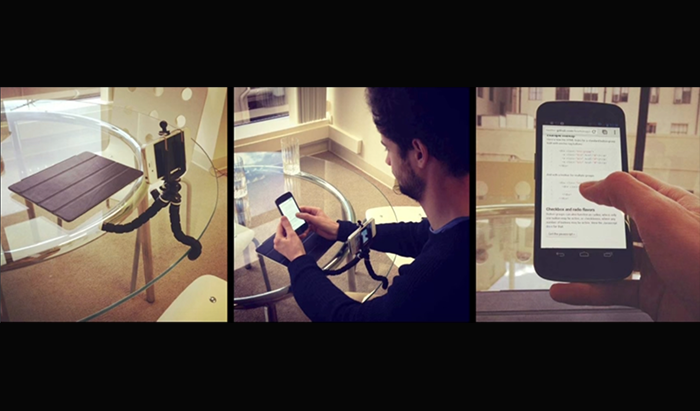
Remotely via Skype interview takes 15-30 minutes. Feedly has a base of adherents who help in testing. I shuffle the design through Skype and ask: what do you understand from this screen? You do not need to say anything, just show the design and ask what it is. It turns out to do design iteration much faster, without coding and production.
The usertesting.com service is such a useful service that we do many tests with it.
Arthur paid a lot of attention to working with this service. There are services for testing products, most of them in English. If someone has experience with such services, please share.
Thanks to Arthur for this video! If you find inaccuracies or errors in the article, write to us.
The article will be useful to those associated with the design of interfaces. The material seems important to us, because many say “communicate with your users,” “listen to your users.” Arthur Bodolec tells how he does it, shares practical steps from his experience.

This article is a free translate-outline, therefore inaccuracies are possible. We will be grateful if you help make the article better.
First person narration, italics are our comments.
')
Hearing is a key skill
Today we will talk how to do design listening. Hearing is a key skill in design.
You all start your projects in the dark. As soon as you find an idea, you see the light. It becomes clear to you what the product should be, you come closer to how it should look. You start coding with friends like crazy. You hope that a year after launch you will enter the IPO. In reality, this does not happen.
Users enter the site and do not understand what it is about; they cannot find the necessary functions. Maybe they don't know what to look for. You begin to study user behavior, to iterate. It is sad that you have already spent 6 months on the launch of the product and only now begin to understand how to use it.
I propose to study user behavior before launch. And tell you how I do it.
First problem: with whom to talk?
The first problem you encounter is finding people to talk to. You can start with friends. But this is not the best choice, often they are not your audience.
If you make a product for homeowners and talk to friends who have never lived in their own homes, there will be many opinions, but they will not be super useful for you. Although it is still better than not talking to anyone, try to filter friends, whether it is your audience or not.
Facebook, mail, Twitter
Use Facebook or Twitter account. Ask subscribers to help, they can be your audience.
If you have already published a draft and you have letters from users, write to them. Ask for 15 minutes of their attention to find out how and why they use your product.

Bulletin Board
If you cannot use these tools, refer to Craigslist ( craigslist.org - the famous ad site ) where you can post a small task. This is a great place where they do not know about your product, but there is your target audience. I will briefly tell you how to work with services like Craigslist. This is what the ad looks like:

In the video, Arthur talks about the site craigslist.com, in our realities, task execution services where people are looking for a side job may be useful.
Put a price in the heading and write what the task is. People looking for a part-time job will understand that this is testing some kind of product, it costs $ 50 and it is in Palo Alto.
- In the ad do not say anything about your product.
- Tell me how long it will take and that you will need to sign an NDA so that there are no surprises.
- Warn that the video will be recorded.
For applications I use Google Form. If a person wants to send an application, he enters the form and answers 5-10 questions. It helps to understand who he is. For example, you make a product for people who like to read. By asking the right questions in the form, you will find out if the respondents really like to read. This will help to get an idea of your potential target audience.

Choose who you want to talk to
You make a list with the criteria of people you want to hear. These questions will help you form the criteria and submit the questions to the Google Form.

For me it is important that users do not use Feedly. I want to see how they use the service for the first time. For example, if the user answers the question: “Which readers do you use?”, He answers: “Feedly”, I will not include him in the interview sheet.
Then you make a list of criteria for those with whom you do not want to talk.

I do not want to talk with designers, programmers and project managers, because they are experts. Their opinions will not be helpful in terms of regular user scripts.
All these requirements you formulate and enter into the Google Form, and then publish. When applications come, you highlight those green that you may be interested in. And after that you can ask the authors of these applications questions, test the product, etc. You can use all these tools - Facebook, Twitter, mail, etc., to find the right people, those with whom you can talk. You select those criteria that are relevant to your product.
Collect real stories
You have selected people, now make sure you understand them. Even before I make a new feature or begin to design something, I collect stories.
You need to collect real stories from real people. Often the problem is that within a company or a startup you are supposed to represent one or several characters. You start to think about who they are: he has two children, a car, a house, he uses this or this product ...
And then you start creating designs for people who don't exist. You imagine that they exist, but it is not. You can guess a few things, but the bulk will be unreal. What you need are real stories from real people. And each time, discussing a function within a team, you can always return to Georges, with whom you spoke, and ask him questions.
This thesis seems to us the main idea of Arthur's speech. Many materials say that we have to imagine the characters, their needs and scenarios of interaction with the product. In practice, it may turn out that we initially come up with a character that is convenient for us, comfortable cases and the needs we need. Which are cut off from reality. And based on this build a product. A product for people who do not exist.
Arthur proposes to take real people as a basis.
How and what questions to ask
Now I will show you the key questions that I ask users to get interesting stories.
First of all, you need to understand who they are.

I ask: “ Did you use any services before Feedly? ". In your case, you can ask how they solved their problem prior to your product.
Next key question: “ Why do you use our product? Or why would you use our product? "
This is the most important question of all and is the hardest to ask. Because, as a rule, people answer not what would be useful. I'll show you an example. I usually write to users on Skype:
- Why are you using feedly?
I always answer: " To read all my subscriptions in one place ."
But it does not really help me in the design. Therefore, using the answer of the user, I ask again:
- Why do you need to read all these subscriptions?
Answer:
- ABOUT! To have access to this information.
Again not very helpful. Therefore, you repeat the method:
“Why is it important for you to have access to this information?”
And then users start saying interesting things:
- To be inspired by a new book .
- Improve my professional skills .
- Know about the latest changes in legislation .
Now I understand who these people are, why they use Feedly, and I can ask my questions further. It helps to create design and features for real needs.

Hearing about any service, ask how the user uses it. For example, Twitter. Both in Feedly and Twitter you can receive information:
- You say you use Twitter, what's the difference between Twitter and Feedly? Why do you use both services?
And users begin to explain to you how they think:
- Feedly is where I get information, Twitter is where I discuss it.
It is very important to know how they see your product, how they see other products. It is important to make this map, it is their perception, not yours. Listen carefully to these things.
If you have enough time, ask more questions:
- What upsets you?
- What one thing makes you happy when you use Feedly?
- If you could leave one function, what would it be?
It is very interesting that if you ask which function to leave one, they call the most insignificant feature. Often the answer will surprise you very much. It is important to get out of your product image and listen to the user. Often you will hear what you do not expect.
Starting a new feature, ask the users about it.
Starting a new feature, before you start drawing anything, take people and check this script for them. Only 3 questions:
- Who are they?
- Why do they use the product?
- Why do they need this feature?
As a result, you get real stories. Which show how people use this or that feature. It is good to have 10-20 such stories. You can hang these phrases on the wall to keep them before your eyes when you create a design. You get a lot of stories, very specific and real, and then you can categorize them.

2 test methods: study and features
Test not necessarily an existing product on millions of users. You can test and draw the layout. You need to get at least some feedback. Do you shoot in the right direction?
There are 2 main methods here.
First: the discovery method
The idea is that you want to test the first experience of interacting with the product or features. You want to know here: do they understand your product or feature?
You put the user in front of the product and see how he understands it. Does he really go through the scenarios that you asked. Can he find the key features that you created.

Key point: you do not interfere in this process. Just give them the opportunity to "get lost", let them go. When will they start asking, “Why is it like this here? Why is that? ”- don't say anything, just give them the opportunity to“ get lost ”. Answer the questions: "I do not know."
Second: feature method
The key point is to ask people to do certain things in your product. Find a feature, buy a product, change a profile, etc. Can they do it?
Can you find _______?
How to start _______?
Before the interview, you simply make a list of what the user should find.
I combine these two methods. I plant them before the product and do not say anything, and then I give tasks and ask specific things. During the interview, it is important to bring a few things:
- You can not do anything wrong.
- Do not be afraid to criticize and offend our feelings, we want to learn.
- Think out loud and tell us what you want to do and what you feel.
- The screen and sound will be recorded.
- No one will say "this is obvious!" Do not be afraid.
It is very important to ask them to think out loud. You care what they think.
Your actions:
- Do not tell about your product, do not customize users.
- Let people use the product and “get lost”.
“If they did something wrong, ask them why they did it.” Do not try to guess. We often guess.
- From general questions go to narrowly focused.
- If something is not clear, explain.
"Ha-ha" moment
You will have a lot of information, but you pay attention to 2 things:
- “Ha-ha” moments.
- Confusing and misleading interface elements.
What is the “aha” moment? One of those moments was when I tested mobile apps. We have seen that when people see familiar websites that they often read, they have an “a-ha” moment (they say “a-ha!”). At this point, they understand why this product. Therefore, it is important to follow such “aha” moments.
3 ways to test: in the office, remotely, through the service
You can conduct an interview or test in the office, remotely or through special services.
In the office, the interview takes from 30 minutes to an hour. 5 people take part, one after the other, but not at the same time. Testing in the office I do with the help of such a device (for recording):

Remotely via Skype interview takes 15-30 minutes. Feedly has a base of adherents who help in testing. I shuffle the design through Skype and ask: what do you understand from this screen? You do not need to say anything, just show the design and ask what it is. It turns out to do design iteration much faster, without coding and production.
The usertesting.com service is such a useful service that we do many tests with it.
Arthur paid a lot of attention to working with this service. There are services for testing products, most of them in English. If someone has experience with such services, please share.
Thanks to Arthur for this video! If you find inaccuracies or errors in the article, write to us.
Source: https://habr.com/ru/post/301394/
All Articles